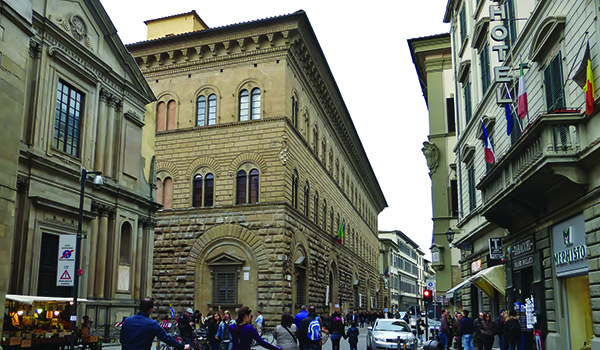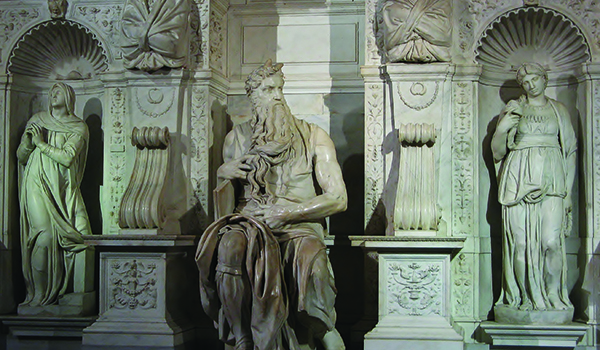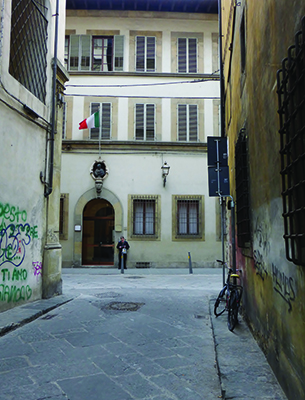On the trail of Lionardo Buonarroti, and the family palace he renovated in Florence.
Lionardo, I have received thy letter and with it the three shirts. I am very much surprised that ye should have sent them … they are so coarse that there is not a farm labourer here who would not be ashamed to wear them.” So wrote Michelangelo from Rome in 1540 to his favourite nephew back in Florence. Lionardo was probably not particularly offended; he was used to his uncle’s irascibility. He knew that Michelangelo was engaged in an uncongenial task – painting The Last Judgement above the Sistine Chapel’s altar for Pope Paul III.
So Lionardo continued to send small Tuscan comforts Michelangelo’s way – cheeses, wine, pears, and better shirts, along with family news and an occasional request for investment advice. Michelangelo’s responses, over time, betray not only affection and occasional exasperation, but his hopes that Lionardo would eventually help him enhance the dignity of the Buonarroti name in Florence.

Michelangelo Buonarroti, sculptor, painter, poet – and family man. It’s true he never married, never had children, and spent much of his time apart from his relatives; but his letters reveal a man as passionate about family matters as about art. His intense interest in restoring his family’s fortunes and status may stem from the circumstances of his early life.
You know the stories, no doubt: born into an old but impoverished Florentine clan; apprenticed at thirteen to Ghirlandaio, the painter; discovered by Lorenzo de’ Medici and educated in the Palazzo Medici, where he studied with Neo-Platonists and created his early sculptures The Madonna of the Stairs and The Battle of the Centaurs.
Throughout most of his life, Michelangelo maintained a prolific correspondence with many people, family or otherwise. Nearly five hundred of his letters survive. He also was one of the best poets of his age, leaving around three hundred poems, mostly sonnets. One of them, in its final lines, helps explain his frequent use of the nude in his art:
Nor hath God deigned to show himself elsewhere
More clearly than in human forms sublime,
Which, since they image Him, alone I love.
Letters and poetry alike express his emotions and preoccupations during a long and eventful career. The early triumphs of the Pietà and the David made him so famous and sought-after, that forever after he was torn by competing demands from powerful patrons, frequently being pulled from one project to another – most famously by Pope Julius II, who abandoned his own tomb project and set Michelangelo painting the Sistine ceiling. He often thought people were conspiring against him, particularly competing artists. Sometimes, no doubt, he was right. Even paranoiacs have enemies.

But he had other concerns besides immortal works, unreliable patrons and scheming competitors. “Lionardo, I have received the sixteen marzolino cheeses … as to buying the house, try to get one of honourable condition … because an honourable house standing within the city will be a great credit to us … for after all, we are citizens, descended from very noble ancestors.” And, later: “Lionardo, I have received the Trebbiano, forty-four flasks, for which I thank thee. The Bishop [of Arezzo] … said he had a good wife to give thee … once more I repeat that I wish thee to marry, so that our family may not finish with this generation…”
There are frequent discussions about purchasing property, and exhortations to find a good, suitable wife are the subject of at least a dozen more letters to Lionardo. “As to beauty, as thou art not thyself the most handsome youth in Florence, it skills not for thee to trouble overmuch about it…” Nevertheless, Lionardo held out until he found just the right young woman, Cassandra Ridolfi; and, when he wrote to tell his uncle how happy they were together, Michelangelo replied: “We thank God for it, and all the more so because such happiness is a rare thing”. And, at last, in April 1554: “Lionardo, I learn from thy letter that Cassandra has given birth to a fine boy, and that she is going on well … all this has afforded me the greatest happiness. May God be praised for it!”
Over time, after his uncle died, Lionardo renovated several family houses on Via Ghibellina into a small palace, and Lionardo’s son, Michelangelo Buonarroti the Younger, enlarged and completed it. It contains many haunting mementos of the great artist, including the Madonna of the Stairs, the Battle of the Centaurs, and Michelangelo’s wooden model for the façade of San Lorenzo (which was never installed). You can visit it today at Via Ghibellina, 70. It is the Casa Buonarroti, an honourable house in Florence

About the writer:
Joe Gartman writes about travel, history and culture, and divides his time between the southwest US and Europe. Learn more at www.joegartman.com
